A German magazine, from Franzis Verlag. Sonderheft der ELO Funkschau Elektronik
KIM-1 articles llike Telefonbuch. See also the page on Telefonbuch restauration.
KIM-1 and more general 6502 articles.
About small SBC systems
A German magazine, from Franzis Verlag. Sonderheft der ELO Funkschau Elektronik
KIM-1 articles llike Telefonbuch. See also the page on Telefonbuch restauration.
KIM-1 and more general 6502 articles.
Found in Hobbycomputer #1 (c) 1980 Herwig Feichtinger (of EMUF fame!) improved by Nils Andreas, a phonebook
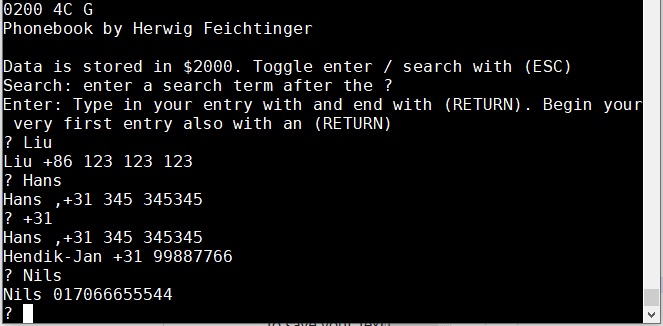
On the github page of Nils you can find source and executables.
In fact, it is a searchable text database.
The program is written, probably by hand, Herwig Feichtinger in the German magazine Hobbycomputer, Issue 1. Available on archive.org.
I took the source as typed in by Nils, added the comments from the (see below) listing in the article and made sure it was binary compatible with the listing. There are some problems with the first entry in the database.
Source, listing, article, binary, papertape of original version of Telefonbuch
; Target assembler: TASM
;*****************************
;* Telefonbuch *
;* (c) 1979 *
;* Herwig Feichtinger *
;*****************************
; typed in and checked by Nils Andreas
; comments entered from German listing into source
; checked for being binary compatible with original listing in HobbyComputer 1 1979
;
; Note that getch in KIM-1 returns with Y = $FF, used in this program to save two bytes?
; Testcase for the KIM-1 Simulator, which now emulates this getch behaviour
;
; Hans Otten, 15 december 2021
;
CR = $0d ; carriage return
esc = $1b ; escape
crlf = $1e2f ; KIM-1 print cr
getch = $1e5a ; KIM-1 read char for tty
space = $1e9e ; KIM-1 print space tty
outch = $1ea0 ; KIM-1 print car on tty
incpt = $1f63 ; increment pointer
;
; zeropage
;
savy = $f9
tablep = $fa ; pointer into table
bufferp = $df ; buffer
table = $0200 ; table starts here
;
.org $0000
;
start: lda #(table & $ff) ; low byte table address
sta tablep
lda #(table >> 8) ; high byte table address
sta tablep + 1 ;
ldx #$17 ; 17 bytes clear
lda #$00
buffer: sta bufferp,x ; clear buffer
dex
bne buffer
;
read: jsr getch ; get ascii character
cmp #esc ; escape?
bne chkend ; no
iny ; yes, y = 0
chkfre: jsr incpt ; increment table pointer
lda (tablep),y ; query buffer
bne chkfre ; free space in buffer?
input: jsr getch ; get ascii character
iny ; y=0
cmp #esc ; escape?
beq start ; yes, back to begin
sta (tablep),y ; no, store in table
jsr incpt ; increment table pointer
jmp input ; and again
chkend: cmp #CR ; return?
beq zzz ; yes, line ready
sta bufferp +1,x ; no, store char in buffer
inx ; increment buffer index
cpx #$15 ; is $15?
bne read ; next character
;
zzz: nop
nop
;
newline: jsr incpt ; table after return
ldy #$00 ; search for character
lda (tablep),y ; in table
beq printquest ;
cmp #CR ; found?
bne newline ; no, search again
found: ldx #$00 ; yes, compare character in table
compbuf: iny ; with character in buffer
lda bufferp +1,x ; no, compare table and buffer
beq printline ; show it
lda (tablep),y
cmp #CR ; return?
beq zzz
cmp bufferp +1,x ; next character
bne found
inx
bne compbuf
;
nop
nop
;
printline:
jsr crlf ; new line
ldy #$01
loadchar:
lda (tablep),y ; load character from table
beq printquest ; zero is ready
cmp #CR ; return?
beq zzz ; end of table entry
sty savy ; save Y
jsr outch ; and print character
ldy savy
iny ; increment Y, next
bne loadchar ; load new character
printquest:
jsr crlf ; print return
lda #'?' ; print ?
jsr outch ;
jsr space ; print space
jmp start ; return
;
.end
Here the pages where the program is described and the listing shown.
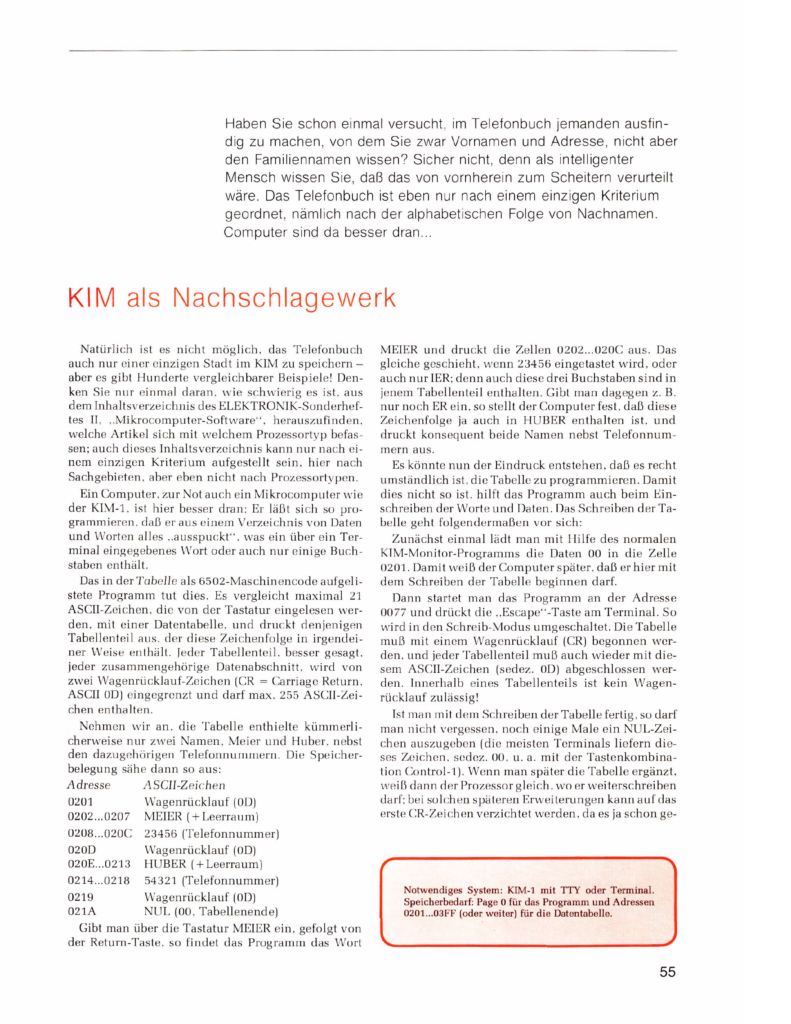
Nils, a very enthousiast PAL-1 user discovered in an old German magazine, 1979, HobbyComputer 1, a small phonebook program for the KIM-1.
It is a command line utility, extremely small and quite clever. See the post about it here.
So he entered the code in assembler and did some tests on his PAL-1 (it worked) and in the KIM-1 Simulator, which was not working.
He found the ‘database’ corrupted.
Of course I had to look at it and see what was going on. It had to be something about using zeropage pointers into the database.
And it was. In the source an instruction appeared:
INY ; Y = 0
followed by an indirect addressing, Y into the database and preceded by a call to getch, reading a character from the keyboard.
Y was not used in the program before, so in the Simulator it was uncertain what the value was.
GETCH is known to destroy the Y register, delivering the character in register A. How is unspecified.
In the KIM-1 Simulator the KIM-1 GETCH is patched to the ACIA routines of the emulated 6850 serial interface.
Those routines do not use Y, so it is left untouched.
So time to study the KIM-1 routines. In the delay a bit routine the Y register is filled with the final state of a counter, TIMH.
It looks like the decrement ends with the value $FF, when the BPL becomes false, the whole purpose of the use of Y seems to determine that end of the loop?
1ED4 AD F3 17 DELAY LDA CNTH30 1ED7 8D F4 17 STA TIMH 1EDA AD F2 17 LDA CNTL30 1EDD 38 DE2 SEC 1EDE E9 01 DE4 SBC #$01 1EE0 B0 03 BCS DE3 1EE2 CE F4 17 DEC TIMH 1EE5 AC F4 17 DE3 LDY TIMH 1EE8 10 F3 BPL DE2 1EEA 60 RTS
Anyway, the KIM-1 Simulator 0.9.4. GETCH routine now returns with Y=$FF and the phonebook program seems to work.
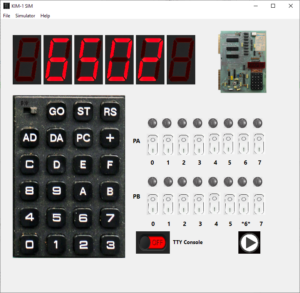
I know KB6 existed. The ‘6’ stands for the precision in digits of the floating point number. In the documentation KB-6 is described.
Never seen a version in the wild. I know KB6 existed. The ‘6’ stands for the precision in digits of the floating point number. In the documentation KB-6 is described. Never seen a version in the wild. So the reconstruction here is not checked with the original, addresses in the reconstruction from the linker differ from the documentation.”>So the reconstruction here is not checked with the original, addresses in the reconstruction from the linker differ from the documentation.
More information on KB9 and a new faster and smaller version
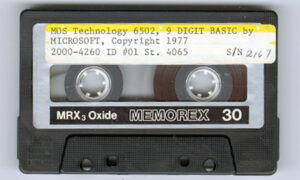
Microsoft’s 6502 BASIC is now Open Source, and that includes KB9 or as it is officially called:
MOS TECH 6502 BASIC V1.1
COPYRIGHT 1977 BY MICROSOFT
Microsoft’s 6502 BASIC is now Open Source
“Now, for the first time, this influential 6502 version is truly yours to explore, modify, and share.”
This means that we are allowed to distribute and modify KB9 and derivates without breaking licenses!
Also see the pagetable post from 2005 that explains a lot about this source.
The license that goes with 6502 BASIC is the MIT License.
On this page you will find:
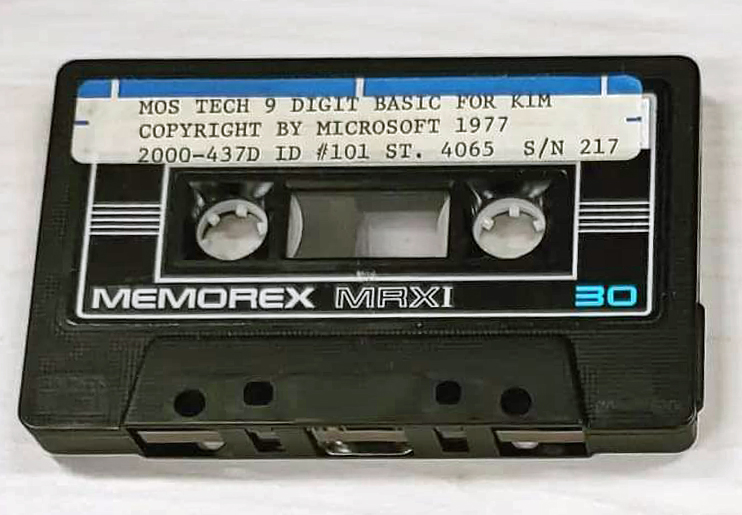
Another MOS TECH BASIC for KIM-1, lower serial number
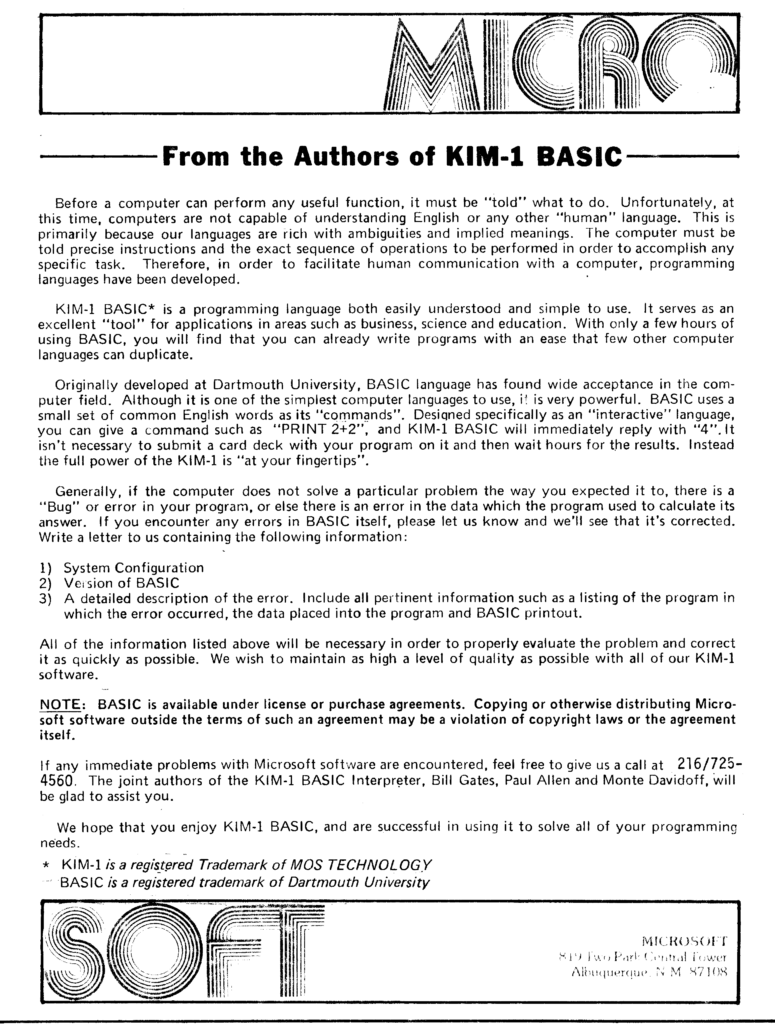
KB-9 stands for Microsoft Basic V1.1 for the KIM-1 with 9 digits precision. Actually, when you run it, it is called MOS Tech 6502 Basic v1.1 Copyright 1977 by Microsoft Co.
The ‘9’ stands for 9 digit precision floating point numbers. A KB-6 (6 digits precision) existed, but no copy ever turned up.
Articles on KB9 in the clubmagazine KIM/6502 Kenner:
– KIM Kenner 4 Siep de Vries Evaluatie 8K Basic, test of accuracy of KB-9, Dutch
– KIM Kenner 5 Uwe Schroder, English, Some Basic problems solved
– KIM Kenner 6 S. Woldringh Patches op 8K Basic Load and Save commands
– KIM Kenner 10 p 10 Microsoft Basic, Hans Otten.
– KIM Kenner 11 p 15 S. Woldringh Patches op 8K Basic part 2
– KIM Kenner 11 p 19 W. van Gelderen Read and Write on cassette for 8K Basic
– KIM Kenner 12 p 15 Patches Microsoft Basic, Hans Otten. Trace mode Renumber
– KIM Kenner 14 p 39 Patches Microsoft Basic, Hans Otten. Calculated line numbers
– 6502 Kenner 16 p 49 Patches Microsoft Basic, W. Blonk Corrections on KIM Kenner 12
– 6502 Kenner 19 p 34 Patches Microsoft Basic, Hans Otten. Speed up Basic 10% with ROR
– 6502 Kenner 22 p 12 Patches Microsoft Basic part 1, van Nieuwenhove Koen, adapt KB-9 to Elektor Junior
– 6502 Kenner 23 p 12 Patches Microsoft Basic part 2, van Nieuwenhove Koen, adapt KB-9 to Elektor Junior
– 6502 Kenner 24 p 14 Patches Microsoft Basic part 3, van Nieuwenhove Koen, adapt KB-9 to Elektor Junior
– 6502 Kenner 25 p 6 Patches Microsoft Basic part 4, van Nieuwenhove Koen, adapt KB-9 to Elektor Junior
– 6502 Kenner 29 p 33 KB-9 Basic on Acorn SYSTEM-1
– 6502 Kenner 32 p 21 W. L. van Pelt KB-9 Basic Tokenized keywords and addresses
All the KB9 KIMKenner articles in one PDF here
Language lab section in the 6502 User Notes:
– Vol 13 Basic tips, Renumber Page 1, Page 2
– Vol 14, Tips, Paging, Automatic Line numbers, the GET statement, USR function
Page 1, Page 2, Page 3, Page 4
– Vol 15 USR Dispatch, Load/save Basic arrays Page 1, Page 2, Page 3
-Vol 16 Line Editor Page 1, Page 2, Page 3, Page 4
-Vol 17 IEEE, Save Load cassette Page 1, Page 2, Page 3, Page 4
After I bought MOS Basic for the KIM-1 in 1978 a lot of study went into understanding and adapting the interpreter. In the Dutch club magazine the KIM Kenner (see above) I and others published my work on it, like tape I/O in hypertape format, calculated goto’s, trace mode, paged output and such.
I modified it later on to suit a bit better to my system, that moved from the KIM-1 I/O to keyboard input via a ASCII keyboard, output to video terminal and a parallel matrix printer Heathkit H14. Even later a real serial interface (ACIA 6850) was used for I/O. I also replaced the startup routine, from destructive to reusable and no questions asked.
Here the Micro Ade source of the patches to V3.0 (Parallel keyboard, video output, H14 printer) and nothing asked non-destructive startup routine. I should rewrite that to the current KB-9 V2 to also include the GET and Backspace patches. V1.3 perhaps?
In the previous section the pagetable article was shown, with resources to recreate from source many 6502 Basic’s, like KB-9.
Here an example how I, quick and dirty, used this to create a KB-9 named V1.2 which is smaller and faster than the original.
This is how to prepare for it (Windows, can be done also on Linux)
Do the adaptations as described below or your own:
ca65 -D kb9 msbasic.s -o tmp/kb9v2.o -l tmp/kb9v2.lst ld65 -C kb9.cfg tmp/kb9v2.o -o tmp/kb9v2.bin -Ln tmp/kb9v2.lbl
First example: use the ROR instruction and suppress nulls sent to the terminal and Clear decimal and fix GET
I changed this:
CONFIG_NULL := 1 ;CONFIG_ROR_WORKAROUND := 1 ; patch HO 2021
COLD_START:
.ifdef SYM1
jsr ACCESS
.endif
.ifdef KBD
.
.
.
.else
.ifndef CBM2
cld ; patch for KIM-1 HO 2021
ldx #$FF
stx CURLIN+1
Assemble and link with the batch file makekb9v2.bat, this will deliver in the folder tmp/
– kb9v2.bin file : load as usual at $2000
– kb9v2.lbl text file
– kb9v2lst textfile
Start KB9 V2 now at location $3F8E, label COLD_START (used to be $4065, so we gained some RAM), see the lbl file.
Here is an archive with all files mentioned above.
And here the new KB-9 V1.2 executable, faster (no ROR instruction emulation) and a bit smaller.
You can test all this with the KIM-1 Simulator (version 0.9.3 lets you load CC65 type of symbol files)
I know KB-6 existed. The ‘6’ stands for the precision in digits of the floating point number. In the documentation KB-6 is described.
Never seen a version in the wild. So the reconstruction here is not checked with the original, addresses in the reconstruction from the linker differ from the documentation.
Perhaps the ROR workaround or the insertion of CLD in the init.s caused this.
KB-6 can be ‘reconstructed’ since other versions of 6 digit Microsoft Basic are in the ‘pagetable sources’.
It takes one define added in define_kim.s, changes on the original file are now:
; CONFIG_NULL := 1 ; patch HO 2021 ;CONFIG_ROR_WORKAROUND := 1 ; patch HO 2021 CONFIG_SMALL := 1 ; patch H0 2021
Assemble and link as above, replace kb9v2 with kb6 in the batch file. See the archive for a working batch file.
COLD_START moves to $3D50, size shrinks to 8K.
Download KB-6 here.
As you can see in the following screenshots it works! Note the number of digits is less, as expected. It should be faster also.
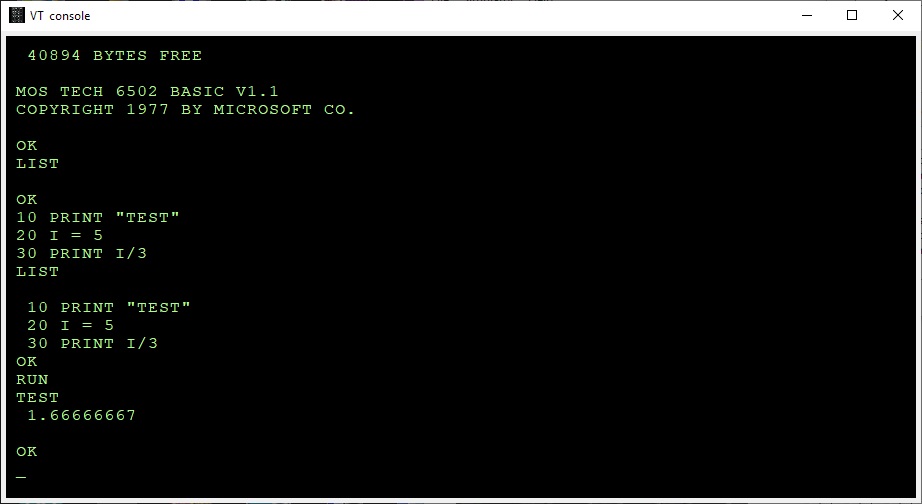
Microsoft Basic for the KIM-1 KB-9
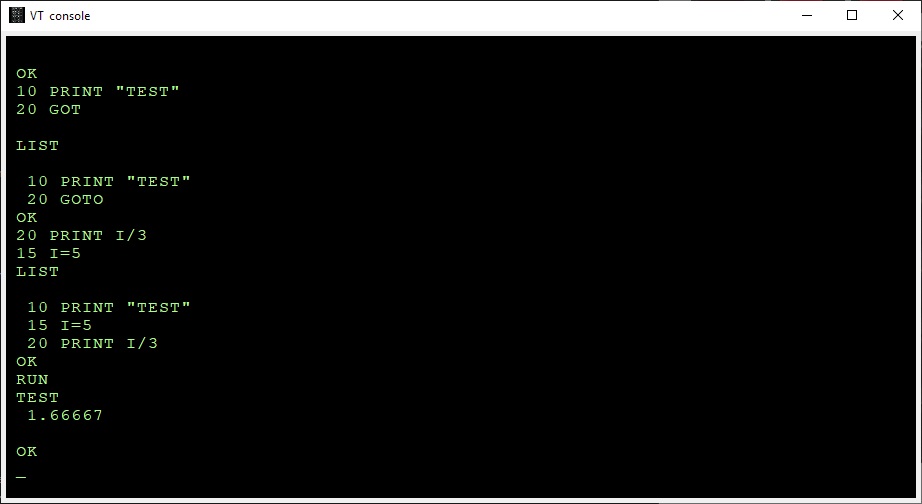
Microsoft Basic for the KIM-1 KB-6, less precision, smaller program size
The bug was described and fixed first by an article in the KIM User note
From the pagetable sources:
BUG: The beq/bne L2AF8 below is supposed to be always taken. For this to happen, the last load must be a 0 for beq and != 0 for bne.
The original Microsoft code had ldx/ldy/bne here, which was only correct for a non-ZP INPUTBUFFER. Commodore fixed it in CBMBASIC V1 by swapping the ldx and the ldy. It was broken on KIM, but okay on APPLE and CBM2, because these used a non-ZP INPUTBUFFER. Microsoft fixed this somewhere after KIM and before MICROTAN, by using beq instead of bne in the ZP case.
.ifdef CBM1
ldy #>(INPUTBUFFER-1)
ldx #<(INPUTBUFFER-1)
.else
ldx #<(INPUTBUFFER-1)
ldy #>(INPUTBUFFER-1)
..
beq 08
You can easily fix this in KB9 by changing the branch in $2AEE from $D0 (bne) to $F0 (beq).
I have fixed this in the source of KB9V2 (KB6 does not have the GET statement) .
Correcting typing errors can be done with the _ key ($5F). On a video terminal, like we use nowadays it can be done with backspace.
The way characters are handled by the input routine do not allow to just replace the compare with _ (C9 5F) with 08 for backspace.
A trick by Jim W4JBM can be used to reuse the BELL handling (07) to a backspace.
Replace in inline.s
INLINAIM:
.endif
.ifndef CONFIG_NO_LINE_EDITING
cmp #$07
beq L2443
with
INLINAIM:
.ifndef CONFIG_NO_LINE_EDITING
cmp #$08
beq L2420
In the original KB9.BIN you can do that with
poke 9260,8
poke 9262,241
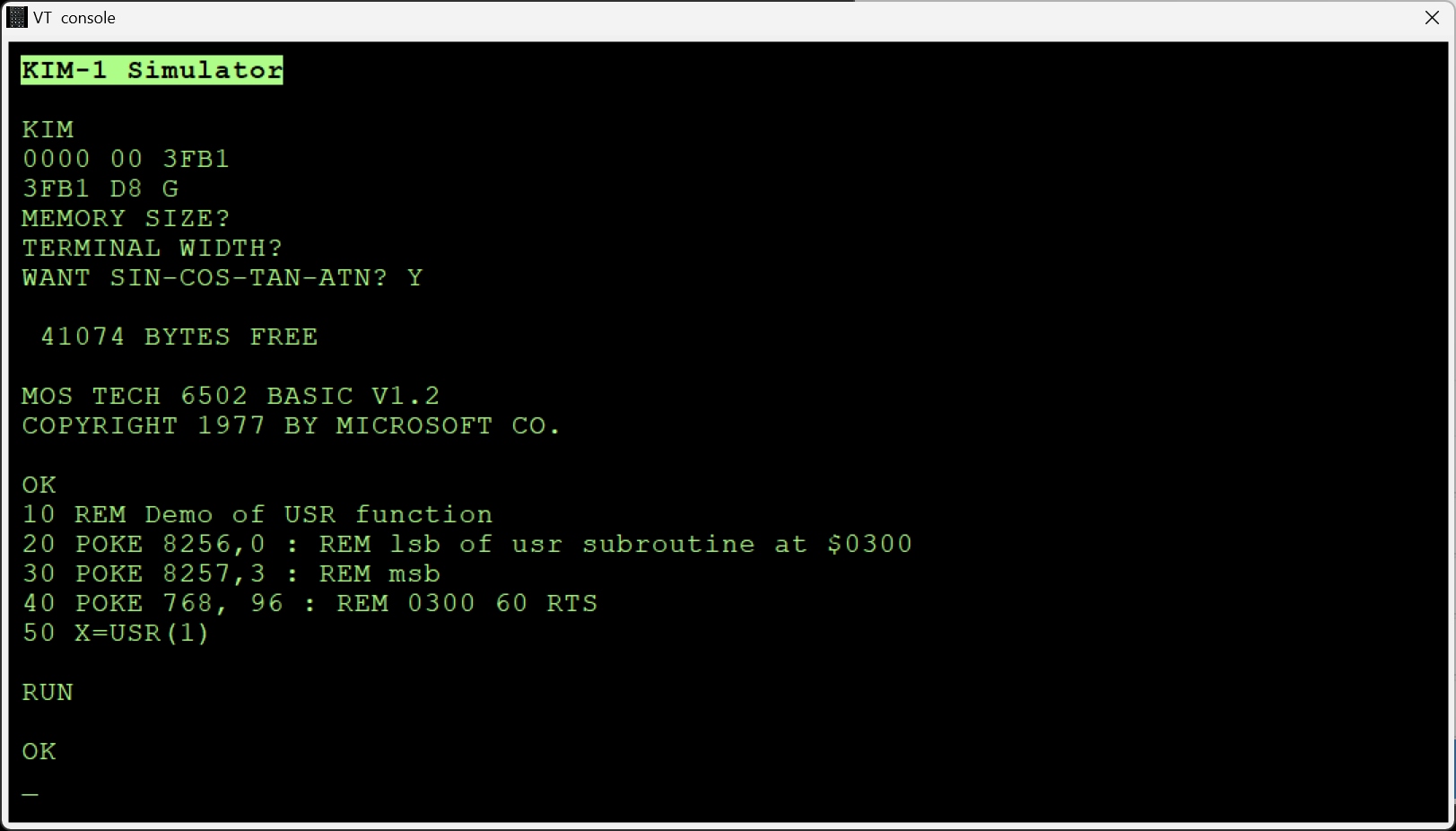
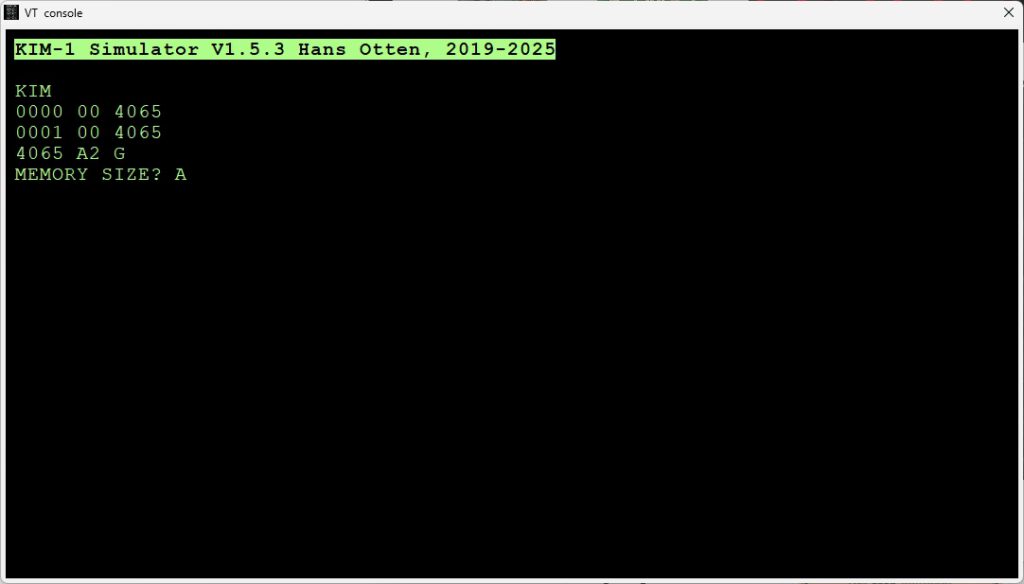

Microchess and MICRO-ADE are two products from Micro-Ware Limited, a company by Peter R. Jennings.
The sources of these two programs have been typed in and assembled by me from August to November 2021, and the resulting binary output is identical to my saved from cassette tape binaries.
All these files (source, binaries, papertape, audio cassette wave files, and manuals) are now
available at the KIM-1 Software page.
In the KIM User Notes there were several KIM-1 games published by Robert Leedom.
A tiny Colossal Cave Adventure, HEXPAWN and Baseball.
With his help and others these games have been typed in again and are playable on any KIM-1 (Reproduction), PAL-1, Kim Clone, Micro-KIM.
In August 2021 I (Hans Otten) typed in the source of MICRO-Ade from the listing in the manual, the output is binary compatible with the binaries I saved from tape and are tested on the KIM-1.
The result is a source identical (in standard MOS Technology assembler format) to the listing and binary identical to the page image. I also made new high quality scan of the manual and the listing.
Micro Ade program source and binary
Scanned manual
Scanned listing
Read in the KIM KENNER archive the source of the enhancements (text by S.T. Woldringh o.a.)
The KIM club enhanced Micro Ade to version 8. Download here the binary with a 2 page command summary.
MICRO-ADE V8